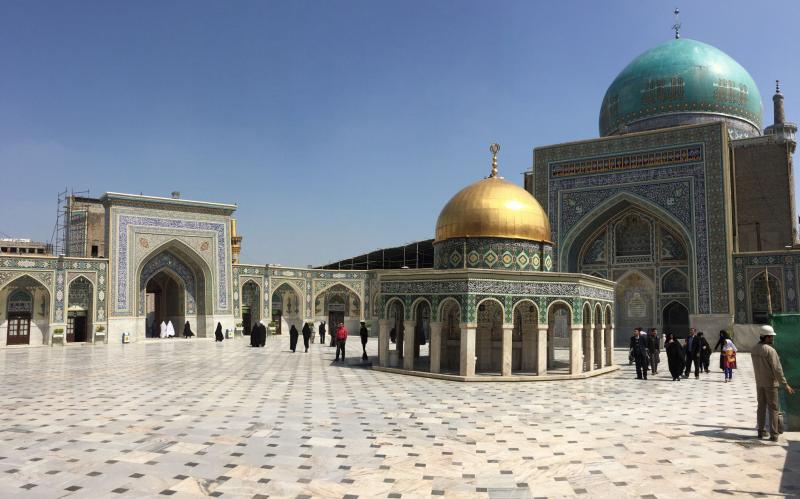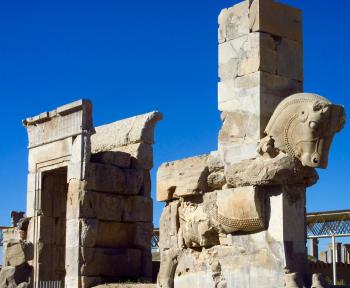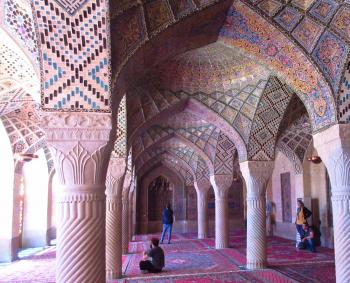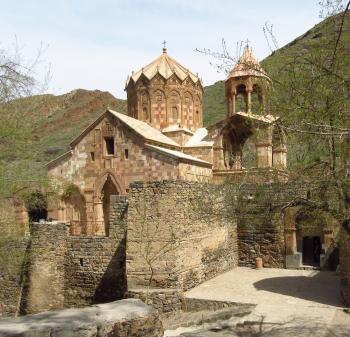Impressive Iran
This article appears on page 6 of the March 2017 issue.
Motivated to return to Iran by the very pleasant memories of our 1972 visit, my wife, Jean, and I took an April 2016 tour of Iran with Distant Horizons (Long Beach, CA; 800/333-1240, distant-horizons.com). We were also heartened by the repeatedly good testimonials written by American travelers to Iran and by the settling of the political environment.
First impressions
We found that Iran had the feel of almost any other destination we’ve visited; that is, there was no “untowardness” in the sights we saw or the people we talked to. We encountered no military presence and no religious fanaticism. For all intents and purposes, we could have been in Italy or Thailand or Arizona.
That said, we did have to travel with an Iranian guide and go through visa protocols, which means it might be easier to go with a group. And women do have to wear head scarves.
Currently, it seems that only high-end tours are available, which means that a trip to Iran is expensive.
Our well-traveled 12-member group was accompanied by a practiced and informative British scholar, Dr. Peter Clark, who had a 30-year career with the British Council, all of that time in the Middle East.
Our Iranian guide, Amin Ale-amad, was also well versed in travel in Iran, and our large tour bus was driven by two experienced drivers. In short, we were in the best of hands.
We were provided with all the bottled water we could drink (though the water in Iranian cities, we were told, is completely potable) and all the comfort stops we needed. There were Western-style toilets in all the hotels and at most of the rest stops, but folks should be prepared to squat on occasion. (Always carry toilet paper on your person.)
The hotels used were the best available and very comfortable, and fine food was laid out for us at every meal.
We really didn’t have to spend much money while traveling (say, $100 per person) except to shop.
Setting out
Our itinerary began in Tehran, where we had three days of sightseeing and sleep recovery before flying north to Tabriz. We also visited Kardovan, a troglodyte village somewhat like those found in Turkey’s Cappadocia region.
From Tabriz, we flew to Mashhad to see the magnificent Imam Reza Shrine, the principal pilgrimage site in Iran for its Shia adherents. The shrine was immense and very peaceful. A guide service for visitor groups was available there to answer any questions folks might have.
We were there for three hours and could easily have returned the next day. The site was really overwhelming.
Following our visit to the shrine, we went to the Hezardestan Traditional Teahouse in the bazaar. In addition to serving lovely food, the restaurant acts as a kind of museum, housing various oddments collected from the 40-year career of its owner.
Into the desert
The next day we drove out to the village of Tus and the tomb of the great Persian poet Ferdowsi, author of the famed “Shahnameh.” Then we took our last internal flight, going to Kerman, located on the edge of the Dasht-e-Lut desert in the eastern part of the country.
Outside of Kerman, we had lunch at an elegant Persian garden in Mahan called Bagh-e Tarikhi, where the approach was a good walk up a series of levels, each featuring a fountain and plantings. For us, this garden was a remarkable example of how gardens are used to insulate people from the dryness of the environment, and they are major features of all towns and cities.
We were greeted warmly, and schoolgirls took delight in hugging the female members of our group, women who could easily have been their grandmothers.
In Kerman, our group visited a gorgeous hammam, or Turkish bath, which had been turned into a museum. We also visited a traditional teahouse in the middle of Kerman’s bazaar, where a musician played the santour, a hammered dulcimer, and a handheld drum called a daf. It was a mesmerizing experience and gave us a little understanding of the Sufi practice of using music to transport consciousness into ecstasy.
Yazd
Our next destination, also on the edge of the desert, was the city of Yazd. We stopped first at a converted caravanserai, where Dr. Clark presented the third of five lectures he gave on the trip. He also would comment on general matters at the various sites we visited. His role was mostly to put Iranian culture into a context that Westerners could more easily understand. He worked as a complement to our guide, who was equally well versed.
Yazd is a center of Zoroastrianism in Iran, although many of that faith migrated to Bombay (Mumbai) in India and to the UK and US in the 19th century. We saw old and no-longer-used Towers of Silence and the Temple of Fire, which holds a flame that is said to have been burning since AD 470.
We stayed at the Moshir al-Mamalek Garden Hotel, which had lovely gardens and enchanting rooms. I should add that our tour price included portering to our rooms on check-in and back to the bus upon leaving. We really didn’t have to lift a finger.
In Yazd we saw examples of two kinds of distinctly Iranian technology: wind towers and qanats. Wind towers ensure cool air indoors even in hot times, and qanats are the underground channels by which water coming down from the hillsides is conducted across miles of terrain without evaporating. Qanats are no longer used, but, in the midst of a drought cycle, Iran’s government is considering reactivating them with modern technology.
The city is also a center of ikat weaving using silk and cotton. We bought a lovely scarf for $25 and then had lunch in the Silk Road Hotel, which definitely had the feel of the overland establishments we had frequented on our 1972 visit.
In Shiraz, our group saw the fantastic Eram Gardens, in the environs of the tomb of the poet Saadi.
The citadel of Karim Khan, now a museum, was beautiful, but it paled before the Nasir-al-Molk, or Pink Mosque.
Esfahan
Next, we embarked on a long day of sightseeing and driving. We started at the fabulous UNESCO World Heritage Site of Persepolis, which was the religious capital of Achaemenid King Darius I. It had majestic portals and fabulous bas-reliefs of animals and people bringing tribute to the Persian king.
Persepolis was an awe-inspiring site, but it was very hot, so hats, sunscreen and water were much needed.
The Achaemenid tombs of Darius and Xerxes (who was defeated by the Greeks at Salamis) were nearby at Naqsh-e Rustam, which also had reliefs from the Sassanid period of the third century AD.
Following lunch in another garden, we embarked on the 5-hour drive to Esfahan (Isfahan), where we stayed for three nights at the divine Abbasi Hotel in the center of the city. This hotel had somewhat modest rooms but lovely dining rooms and one of the best courtyards in the country, a courtyard we spent afternoons in when we weren’t sightseeing.
Esfahan is a beautiful and cultural city. We started our sightseeing there at the Chehel Satoun, or Palace of Forty Columns, which was a Safavid-era reception hall with magnificent painted walls and ceiling. The Safavids ruled from 1501 to 1736 and flowered most under Abbas the Great, from 1588 to 1629.
The heart of the city is the huge Maidan-e-Imam, or Naqsh-e Jahan Square, with Imam Mosque on one of its short ends and the entrance to the bazaar at the other.
During our 1972 visit, the bazaar was the shopping center of the city, but now many merchants, especially those catering to visitors (both Iranian and foreign), have moved into stalls along the maidan (square). Also along the maidan were the Ali Qapu palace and, on the other side, the Sheikh Lotfollah Mosque, so richly described by Robert Byron in his 1937 oeuvre “The Road to Oxiana.” Both the outer and inner domes of this mosque were exquisite.
While we could not enter the Imam Mosque because it was closed for a religious celebration, our memories of it are of a richly decorated structure with multiple iwans, elaborately decorated doorways with inside archways often decorated with honeycomb features.
The maidan, itself, had plantings galore and is a main gathering point for Esfahanis. The overall effect of the maidan was majestic, and it competed with the Shrine of Imam Reza in Mashhad as the single most impressive site we visited.
We later visited the Armenian Church of Bethlehem in New Julfa, or the Armenian Quarter of Esfahan, where we also found a Jewish temple. One of our group members discovered, in talking to antique dealers not far from our hotel, that there were a number of operating synagogues in Esfahan.
In the Armenian Quarter, we had a delightful lunch at Hermes Restaurant, one of several we visited in the country where the ambiance was decidedly modern. Our last day ended in the charming garden of our hotel.
Early the next morning we were transferred to the Isfahan International Airport for our homeward-bound flight.
Final observations
During our tour, we did not want for food at any meal; indeed, by midpoint we were telling our guide to hold off on quantity, particularly the quantities of rice. Breakfasts offered the full range of eggs, bread, cereal with milk, Iranian dishes, yogurt, fruit… you name it. (I have found that a daily helping of yogurt calms my stomach better than Pepto Bismol.)
For lunches and dinners, our guide would tell us of particular specialties of the house and what was generally good. We gorged on lamb; at several places, the chops were especially delicious. Bread, soup and salad were also in abundance. There was chicken, fish and even pizza. At no point did anyone get sick from the food.
My personal thrill was having good chocolate milkshakes at three different restaurants. And I can now recommend saffron ice cream.
Our 15-night trip with Distant Horizons cost $6,120 for the land portion. For 2017, trips are scheduled for April and October.
The company provided all manner of advice and supporting data, including a complete reading list. They also facilitated prepaid tips of $12 for the guide and $6 for the bus drivers (per person per day).
Our accompanying scholar was not tipped, but we all chipped in to buy him a nice gift. Everybody was most deserving.
Each visa cost $90, and we used the recommended visa service for an additional $50 (or $90 for priority service). You must provide an Iran-issued visa-authorization number — probably hard to get if you’re not on a tour. Visas are currently issued by the Iran section of the Pakistan Embassy in Washington, DC.
While one can enjoy this tour without spending additional money, it would be pound-foolish not to take cash in US dollars. We took $1,000 and spent $400 directly on purchases (yes, many merchants in Tehran, Shiraz and Esfahan accepted US dollars) and exchanged $300 for Iranian currency to purchase miscellaneous items.
We have found that carrying a reserve of $300-$500 in US currency often proves helpful when traveling. (For the fearful, know that each hotel had a safe in every room.)
Generally, you cannot use a non-Iranian credit card in Iran, although a few merchants have established accounts in Dubai and will accept US credit cards.
You might consider breaking your journey to Tehran by staying three to four nights in Istanbul and/or staying an additional two days in Esfahan.
I’d like to reinforce the fact that we had nary a worry nor lacked for comfort on this trip.
Our excellent local guide told us that the Distant Horizons itinerary was the most complete of the itineraries of the companies that he dealt with. We really could not have asked for more. Though the trip was expensive, it was a tremendous value.
If you seek particular information, I am happy to be contacted at goddard
@rcn.com.




